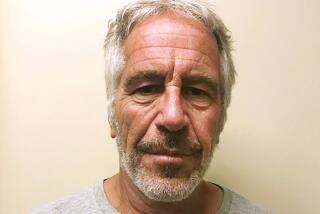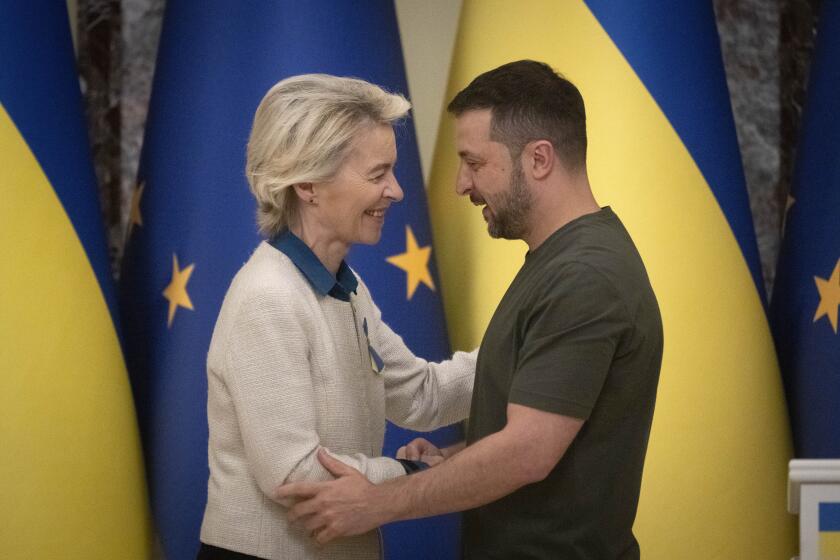Tangled vine of dreams, reality
Like many black professionals during the dark days of apartheid, Diale and Malmsey Rangaka dreamed of leaving the crowded township of Soweto. But, unlike their neighbors, they didn’t want to move to the gated white suburbs.
They wanted to be farmers.
For years Diale, an English literature professor, would chatter away about cattle ranching, quoting the latest issue of Farmer’s Weekly. His wife was skeptical. “But you haven’t produced so much as a rabbit your whole life,” she would gently chide him.
But Malmsey, a clinical psychologist, harbored her own ambition: She wanted to be an organic farmer. To which her husband would invariably point out that she hadn’t grown so much as a carrot.
A few years ago, with their children grown and land ownership suddenly open to blacks, they began scanning advertisements for farmland. Twenty-two farms later, their quest ended. It was neither a ranch nor a vegetable farm but a moldering 100-acre tract of grapes and guava.
They quit their jobs, borrowed the entire purchase price from the government land bank and moved nearly 800 miles southwest, leaving the coal-fire haze of their black township to take up a life that had once defined the white Afrikaner settlers in South Africa.
They were a pair of dreamers, cultured urbanites with romantic visions of green acres and the cleansing power of an honest day’s work. They were in for a few surprises.
This corner of the Western Cape province is a bucolic region of rolling hills, Cape Dutch architecture, dramatic mountain backdrops and quaint villages. The area’s two-lane roads are speckled with signs bearing drawings of grape clusters and the names of passing vineyards. Stellenbosch, the center of South Africa’s wine industry, is just a few miles away from the farm.
When the Rangakas arrived in late 2003, their farm was in sad shape. Repairs had been neglected and the vines were old. But at least they were inheriting a staff of farmworkers who lived on the property.
The Rangakas knew that relations between some white farmers and their laborers were poor. They thought being black -- and the shared experience of being victims of white-minority rule -- might help them.
But the couple soon discovered that skin color wasn’t quite as important as history, tradition and language.
The farm’s four permanent laborers were mixed-race Colored and spoke Afrikaans, as do most white farmers here. In the racial hierarchy under apartheid, the lighter-skinned Coloreds, who are a majority in the province, were a notch above blacks. And 15 years of black majority rule hasn’t fully erased that feeling of superiority.
The dayworkers were ethnic Xhosas, blacks from impoverished rural areas of the Eastern Cape province, and they spoke Xhosa and Afrikaans.
Diale, 55, and Malmsey, 53, are both Tswana, from northern South Africa. They spoke Setswana and English -- and very little Afrikaans or Xhosa.
“It was an interesting situation,” Malmsey said, her sigh suggesting an understatement. “They spoke Afrikaans and Xhosa and were used to working under a white farmer. They saw we were black and they weren’t used to it.”
After a few months, three of the four laborers asked to speak privately to Diale. They tendered their resignations.
“They said they liked working for us but they couldn’t get used to having a black boss,” Diale recalled. “It was amazing to me.” Later, the foreman resigned too, citing the difficulty of working for a woman, especially one he couldn’t communicate with.
Later, the Rangakas learned that their laborers were being mocked by other Colored farmworkers as “slaves” for working for blacks.
That was just the beginning of the culture clash.
During the first guava harvest, black farmworkers from the area would pull up in their pickups and take scrap metal from the Rangakas’ property. “They never came to the house to ask. They just took what they saw laying around and thought we weren’t using,” Malmsey said.
Then, when the guava ripened, “they would take away fruit by the vanload,” Diale said. “When we asked them why, they said they were told that if you needed guava, just to come.”
Diale put up fences. But they were ignored.
“I had to go out there and tell people that the whole purpose of a fence is that if you are standing on one side, you can’t go to the other,” he said. But what really surprised Diale was that the scofflaws, when caught, never seemed to feel guilty.
Being a former literature professor, Diale at first tried to understand their motivation. While this might look like ordinary thievery to some, he thought, perhaps it had deeper meaning. “I really wanted to understand why they were picking our fruit and taking it for themselves,” he said.
He concluded that the intruders had a perception that, as black farmers, Diale and Malmsey were a resource for fellow blacks who had less. And many of them had grown up in communal Xhosa villages where fruit on trees belonged to everyone.
So, Diale began pointing out to the interlopers that, unlike in their home villages, his guava trees were planted in straight rows. “I just had to explain that was my property,” he said.
Relaxing on their veranda in the evenings, the couple would shake their heads as they watched the show. They were more bemused than angry. “I’d sit here with Malmsey and say, ‘Can you believe it?’ ” Diale said.
Over the next few years, the Rangakas hired dozens of workers. Most left after a few months.
But they were slowly becoming farmers, and it was rough work -- “the farm is so insistent that ‘I shall be weeded,’ ” Diale said. They wanted to make their own wine but didn’t know much about it. (In fact, Malmsey didn’t even drink alcohol.) The previous owner had sold grapes to a local cooperative, and there was no winemaking equipment on the property.
The Rangakas were the only black owners among the dozens of vineyards in Stellenbosch, and they felt as if they were in a fishbowl. Months passed, and none of their neighbors even stopped by to say hello.
One day, though, two white men appeared on their doorstep. Diale’s first thought: “Oh God, what have my kids up in Soweto done now?”
But things were about to look up. The men were Simon and Jeff Grier, cousins whose family owned the Villiera vineyard a few miles away.
As they talked, Diale mentioned that he was preparing to prune his vines. “That’s interesting,” Jeff, the winemaker at Villiera, replied politely. “Why do you want to prune in November? We usually prune in June.”
Diale was stunned. He had been devouring wine magazines, preparing himself to tend his new vineyard. But he hadn’t realized that he’d been reading about vineyards in the Northern Hemisphere. Here in the Southern Hemisphere, the seasons were reversed and November was the beginning of the growing season.
Meeting the Griers was a stroke of good fortune in more substantial ways. The Villiera label was an established South African wine, and the Griers were known for both their eco-friendly approach to farming and for encouraging black South Africans to take up wine production.
The Griers invited the Rangakas to a wine tasting and the two families became friends. Soon, Jeff Grier offered to mentor Diale and Malmsey and use the Villiera facilities to make their wine.
Diale and Malmsey eagerly accepted. They named their new label M’hudi, a Setswana word meaning “harvester.” They had another reason for picking that name: It was the title of the first novel written in English by a black South African -- and the name of its plucky heroine. “We think our wine has her spark,” Diale said.
The Grier family’s decision to help was not so much a high-minded effort to break the color barrier as an attempt to rescue the Rangakas before they drowned.
“They had decided on their own to dive into the deep end,” said Cathy Grier Brewer, director of sales and marketing for Villiera. “And we decided we’d better help them.”
The Rangakas may not have known much about winemaking, but they were hard workers and had a knack for marketing, something the Griers admired. “You can have all the grapes and cellar space in the world, but you need to be good at the marketing side,” Brewer said.
Today, with the help of the Griers, the Rangakas produce about 7,200 cases a year of M’hudi wine, mostly Sauvignon Blanc and Pinotage. About 90% is sold overseas, half of that in the United States through Los Angeles-based Heritage Link Brands.
Their three children now work part time in the business, and their daughter, Lebogang, 30, is working on an MBA specializing in the wine industry from Stellenbosch University.
The Rangakas have plans to create their own cellar and open a tasting room for visitors.
So far, though, their efforts to get permits have been slowed by objections from some of their white neighbors. Even if they get the permits, they’ll face the hurdle of getting financing during a time when South African wine sales in general are sagging because of the global financial crisis.
But every day brings new successes as well as new challenges.
After watching farm laborers come and go, the couple recently hired three new ones. They are pretty sure these will stick around. All of them speak Sotho, a language very close to Setswana.
A few weeks ago, a white man from a government department came by to check on the M’hudi farm. The only thing Malmsey remembers from that conversation was something the official said: “How did you get yourself into this mess?”
She laughs at the memory.
“When we came here, we had a glamorous idea of living in the wine country,” she said. “But there are many myths about this life.
“Our friends back in Soweto keep wondering if we’ve adopted the ‘larney’ life,” she added, using the South African word for “white boss.” “In reality, it’s very, very hard work. But we love being on the farm. We know we made the right decision.”
--
More to Read
Sign up for Essential California
The most important California stories and recommendations in your inbox every morning.
You may occasionally receive promotional content from the Los Angeles Times.











